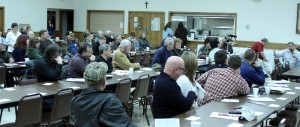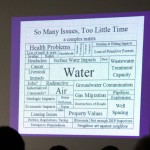 An informational public meeting was held about the dangers of Marcellus Shale drilling Thursday night at the St. Timothy’s Catholic Church in Curwensville. The presentation was given and organized by Stephen Cleghorn and Carol Houser of the Pennsylvania Alliance for Clean Water and Air.
An informational public meeting was held about the dangers of Marcellus Shale drilling Thursday night at the St. Timothy’s Catholic Church in Curwensville. The presentation was given and organized by Stephen Cleghorn and Carol Houser of the Pennsylvania Alliance for Clean Water and Air.
The meeting was held in two parts. The first included a slide show given by Cleghorn which was followed by a question and answer session. Young and old attended the public forum in what was a packed room. Local and county public officials were invited to attend, but according to PACWA representatives no invites had been sent to representatives of companies with interests in drilling. According to both Houser and Cleghorn such companies, such as Consul, had been invited to a prior identical presentation Sykesville, but the invitations were declined. Cleghorn also said he had sent a copy of his presentation to pro-Marcellus corporations seeking commentary, but had yet to hear anything back.
The goal of the presentation was up front. Marcellus Shale is the latest bust energy harvest in Pennsylvania after coal and wood. Cleghorn provided sources for his information and information showing the argument for both sides of the debate. His sources included energy companies such as Chesapeake Energy, Range Resources, Pennsylvania State University, Dr. Anthony Ingraffea of Cornell University, and Senator Bob Casey to name a few.
Clegorn focused on High Volume Slickwater Fracking Long Lateral, HVSFLL, drilling. Cleghorn admitted that with this form of drilling less wells than traditional drilling. Traditional drilling requires one well and goes straight down. HVSFLL can have up to several wells per drilling pad and can cover one square mile, or 640 acres, at ideal conditions.
HVSFLL is a type of gas extraction through fracking, but is not the only method of fracking. It was stated that only around 30,000 of the million of fracked wells have used HVSFLL so far, or three out of every hundred wells. Cleghorn differentiates HVSFLL drilling from the 60 year old practice of hydraulic fracturing, and
Benefits to drilling include that it helps US energy needs, provides jobs directly and indirectly, leases and royalties also provide money to the area and natural gas burns cleaner compared to other fuels. HVSFLL drilling provides benefits over conventional drilling through being able to get more gas from fewer pads and can reach Marcellus gas that would not normally be reachable.
While there are positives to Marcellus gas, Cleghorn mentioned Pennsylvania’s past history with energy harvesting and booms. The state is still recovering from acid mine drainage from its coal history. Cleghorn stated, citing Dr. Ingraffea, that fracking poses threats of chemicals, heavy metals, Natural Occuring Radioctive Materials (NORMs) and Volatile Organic Compounds (VOCs). Drilling can release greenhouse gasses such as methane.
Additional risks stated by Cleghorn were environmental impacts, health to humans and livestock, road damage, possible loss of jobs and a reduction of property values.
With environmental damage the reported low chance of problems emerging, but referenced the Deep Horizon incident in the Gulf of Mexico. Cleghorn brought up a few times that there are no studies showing the conclusive safety or danger of Marcellus drilling. That the gas industry is exempt from the Federal Safe Drinking Water act that requires a ten thousand year limit on chemicals rising to the groundwater aquifer. With 90% of drilling fluids staying in the ground that a 4 million gallon fracturing job will leave 72 tons of chemicals in the ground. The argument presented that it would take one bad failure in safeguards for devastating effect.
Cleghorn gave statics for the industry citing 2.5 years of Department of Environmental Protection as the source. Looking at 45 drilling companies there were 1056 violations with environmental risks. Averaging 1.1 environmental risk violations a day between the 45 companies, but made no mention how the violations were distributed among the companies.
Another slide displayed statistics from three days in June 2010 from the Pennsylvania State Police. 1,137 trucks were inspected over the three days with 131 waste water trucks being removed from service and 23 waste water drivers removed from driving. Every tenth truck inspected had either the truck or the driver of a waste water transport removed over those three days.
Cleghorn begged the question regarding water with recurring reports after drilling of pre-existing wells going bad, and the correlation involved. Dimock, PA was mentioned, but Cleghorn stated that Dimock’s water problem was not from hydraulic fracturing drilling. He did say it was drilling related, though.
As with the wells, health problem correlations were also brought up with reports of a family in Wise County, Texas in what was described as “Barnett Shale country” corresponding to illnesses in Stilt Mesa, Colorado, and a family from Fayette County, Pa.







